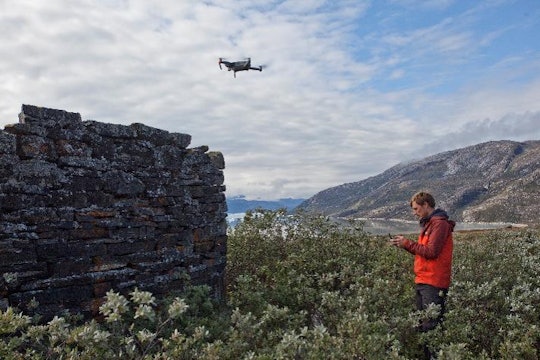
Roberto Fortuna, Nationalmuseet
Climate change is rotting away Greenland's cultural heritage
Archaeologists are moving as fast as they can, but the past is slipping away
I can’t look away from the dead child; his soft, dark hair, his lips partly open, the long, black eye-lashes on those empty sockets. His tiny face is tilted to one side, as if questioning something. The hunters who found this fragile child in a north Greenland cave at first thought he was a porcelain doll. But this little boy is as real as his mother and the six other family members buried in that cave more than five hundred years ago and remarkably preserved in the cold, dry Arctic air for centuries.
I first saw the boy and his family during a visit to the Greenland National Museum and Archives in the capital, Nuuk, where the remains were moved after scientific investigations in Denmark in the 1980s. They are just one of thousands of artifacts that document Greenland's rich history of human migration, preserved so remarkably in the frozen soil, protected by remoteness in a country undisturbed by roads or railways.
There are around 6,000 registered archaeological sites all over Greenland -- and many thousands more that have yet to be discovered. Stone tent rings, meat caches, foundations, field flowers and cultivated grasses growing where once there was a farm, and even burial sites. These artifacts tell stories that are waiting to be discovered, to be documented, to be understood.
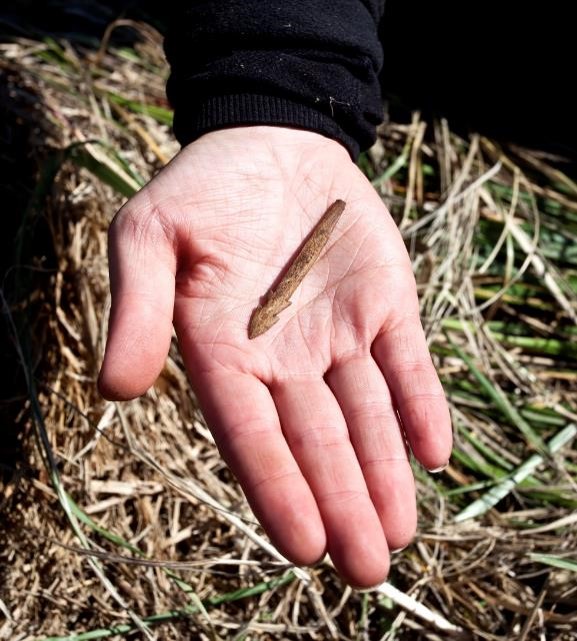
Roberto Fortuna, Nationalmuseet
But many of these stories will now be lost before they are even found. They are literally being washed away, according to the stark findings of the few archaeologists working in the Arctic. In 2018, researchers from six Arctic and European countries reviewed the state of Arctic archaeological sites. Their findings, reported in the journal Antiquity, make for grim reading. The Arctic once offered a pristine time capsule for archaeological remains, frozen into the permafrost. But over the past 40 years, the Arctic has been warming at twice the global average, melting of the ice cap is accelerating, and the permafrost along that thin strip of land that holds Greenland’s precious record of human migration and occupation, is defrosting.
“It’s easy to say that climate change is destroying everything,” says lead author Jørgen Hollesen, senior researcher at the National Museum of Denmark, “but I wanted to know the current scientific status, not just opinion. From the beginning, I wanted to make it based on facts, not emotion.”
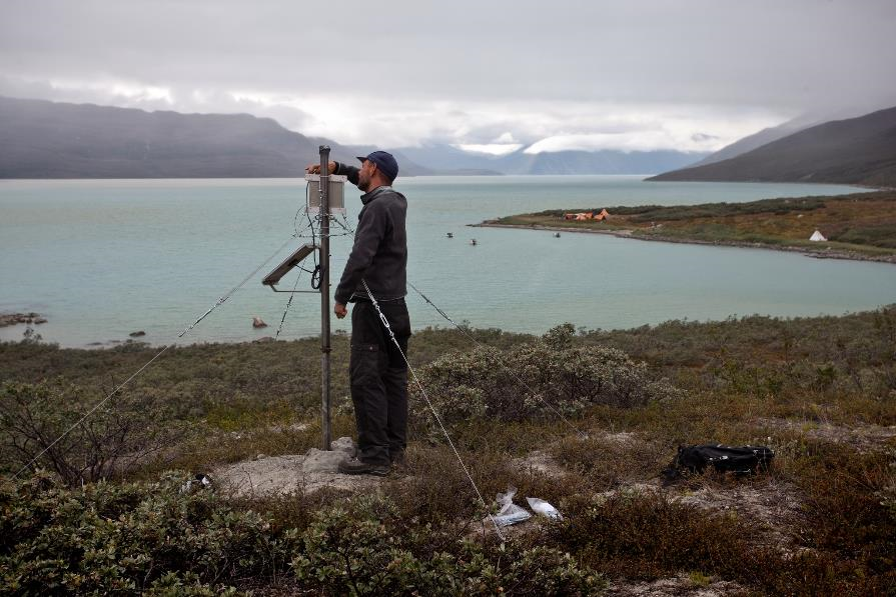
Next to a lake ringed by mountains, a scientist sets up a surveying probe.
Roberto Fortuna, Nationalmuseet
Hollesen and his colleagues' review finds clear evidence that a range of climate-induced factors are deteriorating or destroying archaeological sites across the Arctic; coastal erosion through reduced sea ice, increased sea levels and storm events, warming soils and melting permafrost, increased subsurface oxygen promoting decay and microbial action, increased run off, and increased and changing vegetation. And the rapidly changing natural processes are affecting thousands of sites, all at once.
An example is middens, rubbish heaps of the past containing wood, bones, feathers, and fur that serve as a rich source of information about how people once lived. But middens, such as those at the deserted settlement of Kangeq, near the capital Nuuk, where people lived over thousands of years, are now in decay. The organic remains in the Kangeq middens are turning to mush in the rapidly melting permafrost, and being washed away by increased storm activity.
So how does one begin to deal with these problems? One small start is the REMAINS of Greenland project, a partnership between the Greenland National Museum and Archives, the National Museum of Denmark, and the Center for Permafrost Studies (CENPERM) at the University of Copenhagen. The project was designed to understand the factors controlling preservation of Greenland’s archaeological sites and to develop a baseline to identify and manage sites at risk. Where historically the norm has been simply to document archaeology, the REMAINS project took a holistic view, looking at the whole picture of the environmental and human setting of archaeological remains, past and present. What was the environment in which these people lived? How has it changed? What are the current climate-induced impacts on these sites?
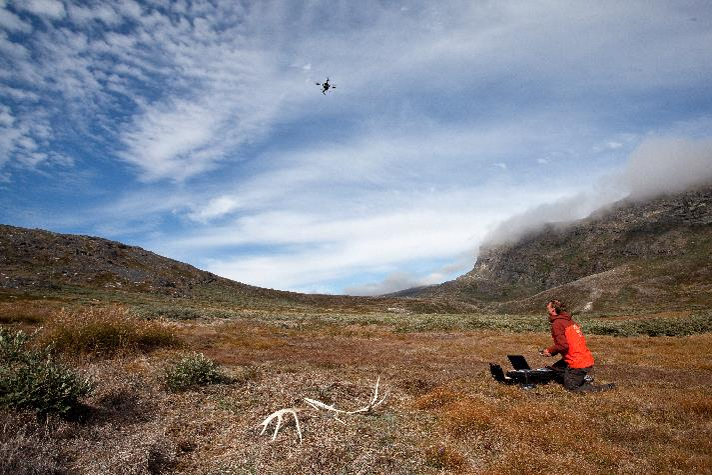
Drones over Greenland.
Roberto Fortuna, Nationalmuseet
The REMAINS project was also different in being multidisciplinary; the field-based studies involved geomorphologists, plant biologists, geographers, permafrost experts, conservators, archaeologists, and specialists working on high precision drone mapping of sites and spectral analysis of vegetation. As well as documenting the present conditions of sites, compared with historical records, REMAINS scientists installed monitoring equipment to document real-time changes in site conditions.
Comparisons with historical records show that vegetation has increased and changed at many sites. Roots are damaging buried artifacts. In a paper in review, researchers argue that the high levels of soil nutrients at these sites – from past human occupation – are now promoting vegetation growth in the warming soils. And the effects of those warming soils on artifact preservation is clear over a time scale of just a few decades. In the 20th century, Norse sites in South Greenland produced remarkably preserved textiles and leather. “But now,” says Dr Hans Harmsen, curator at the Greenland National Museum and Archives, “if you find a site with even moderately good preservation, it’s a really good find.”

Wet and decaying.
Roberto Fortuna, Nationalmuseet
While the REMAINS project has been limited in sample size and duration, says Harmsen, “it has allowed us to establish a methodology, to create a baseline. We want to know what’s happening, at least through a couple of years and a couple of seasonal changes.”
This baseline is a key outcome of the REMAINS project. Now, scientists have some idea which environments are at high risk of dramatic impacts on archaeological sites, and in which deterioration might be slow and gradual, where there is more time. In this way, the scientists hope that the baseline they are creating will allow them, ultimately, to be able to triage known sites; to assess and protect or, if that’s impossible, to excavate valuable sites that are at high risk of being lost.
While these are worthy goals, Harmsen is quick to point out the challenges in making that happen. While Greenland has over 27,000 miles of coastline, and many thousands of archaeological sites, the Greenland National Museum and Archives employs just two full time archaeologists. And while the cross-disciplinary focus has proven productive, that is also a problem in itself. Research funding is distinctly partitioned into human and natural sciences with little overlap.

Another site, not enough scientists.
Roberto Fortuna, Nationalmuseet
“On paper it looks good,” says Hollesen, “but in practice it’s often difficult to get money for things in between.”
With these challenges, so much yet to learn, and so much environmental time pressure, the tasks ahead seem daunting. Take a kitchen midden, for example, an incredible record of how people lived in the past, how they dealt with changes to their own environment, and containing a wealth of human, plant, and animal DNA evidence. A new technique, called Bulk Bone Metabarcoding, pioneered by Frederik Seersholm and colleagues from Curtin University and the National Museum of Denmark, allows species-level identification of fine-grained material from these deposits. "This gives us, as one example, a bigger picture of the menu of those people," says Harmsen. But there’s no telling what might come out of that one day. We probably don’t yet realize the full potential of what we might be able to unlock, but once it’s gone, it’s gone.”
So, is the general scientific consensus that climatic effects are having a dramatic impact on archaeological sites?
“Yes. Definitely,” says Harmsen.
And given the scale of the problems, how, and where, do we focus our attention? An obvious answer is the new UNESCO world heritage area in South Greenland, which provides a focus, and perhaps new funding possibilities. Inscribed in 2017, the Kujataa site preserves a rich record of Norse and Inuit farming from the 10th century onward. But the threats to the preservation of that record are clear.
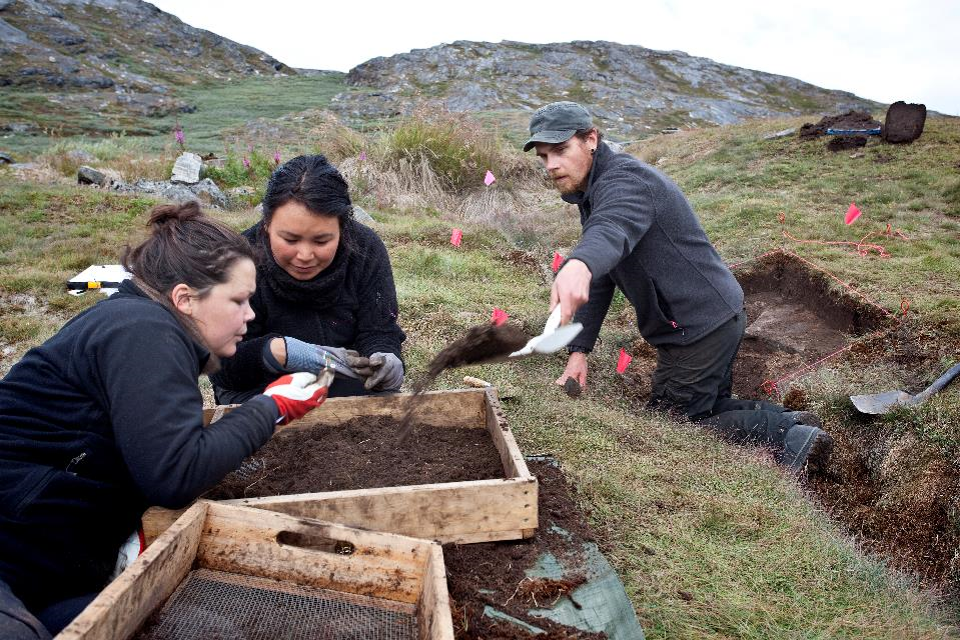
Always more work.
Roberto Fortuna, Nationalmuseet
What would it really mean to lose this cultural heritage? Who should care and who should be doing something about it? If you ask Hollesen, the answer is everyone.
“Cultural heritage is not static. We have to take care of it, protect it. If you want to build a house, you’re required to protect any archaeological remains in the soil, not destroy them. But the whole world is changing the climate, and no one is taking responsibility for this.”
For Greenlanders, their cultural heritage is right there in their backyard, and in their immediate past. In the Nuuk area, families will travel to the same sites every summer where their ancestors hunted, the same sites where the Norse lived. “If we want future generations to have these sites, these opportunities to hear about the past, we need to do something,” says Hollesen. There is a common story that links us all, past and present, and in Greenland that link is tangible… for now.
